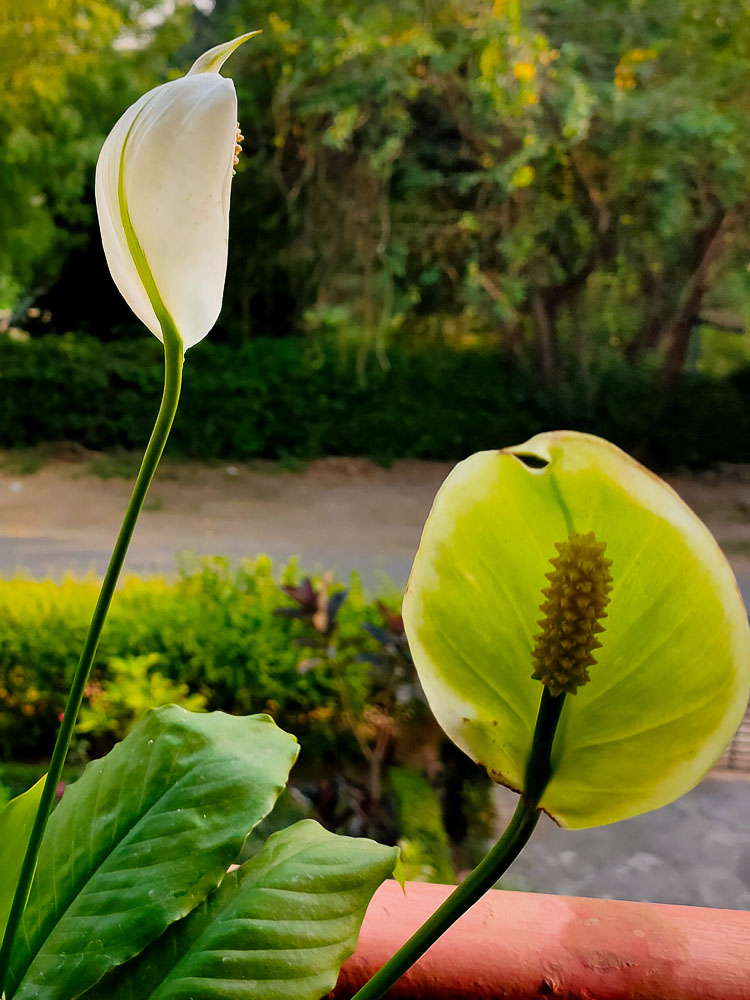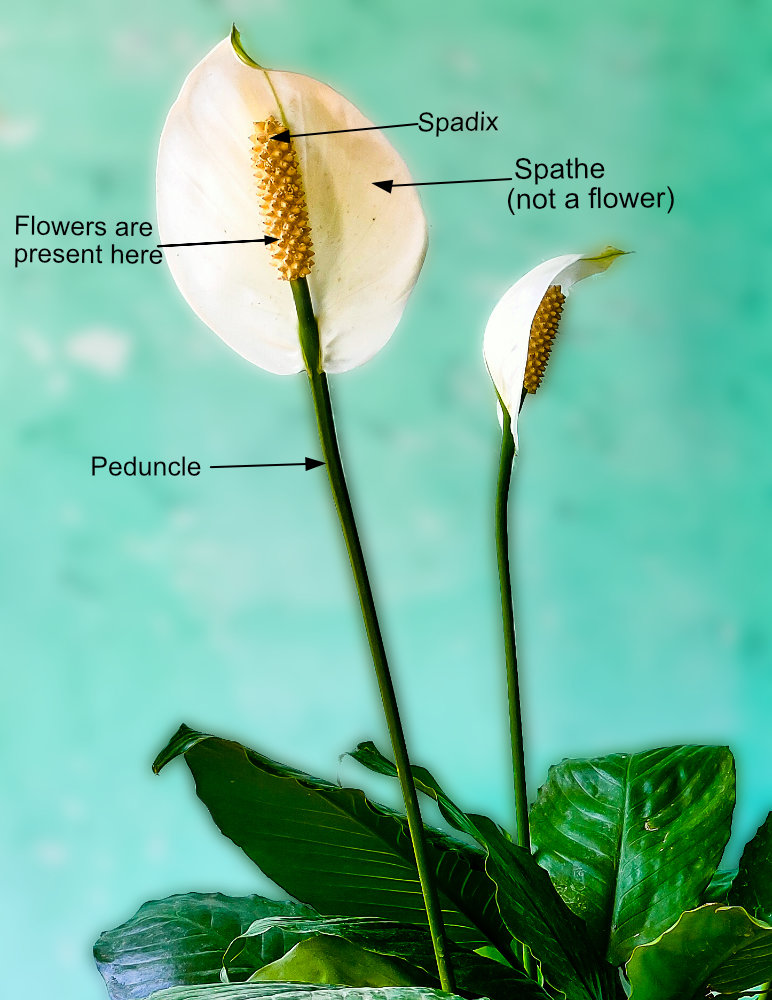PEACE LILY OR SPATHIPHYLLUM
-“an efficient air purifier”
When we talk about indoor plants that are beautiful as well as efficient air purifiers, the name of Peace Lily comes to our mind. It is one of the best, easy –to-grow and low- maintenance plant which every plant lover wants to add beauty, colour and life to the indoor.
Peace Lily, also known as White Sail Plant or Spathiphyllum, does not belong to Lily family (Liliaceae) but is a member of Arum family (Araceae). This plant has a quiet elegance due to its shiny, creamy, white flowers that are held high on stiff stems contrasting well with the dark green foliage. However, what most people thought of as flower is actually a specialized leaf bract (spathe) that grows hooded over the flowers. The spathes resemble the white flag of peace and surrender and in the olden days gave an impression of the sails of a ship. Spathiphyllum wallisii, in addition to its indoor use is also suitable for landscaping in warm climate regions. Let us discuss this plant in detail.
FACT FILE
Kingdom: Plantae
Order: Alismatales
Plant family: Araceae
Sub–family: Monsteroideae
Botanical / Scientific Name: Spathiphyllum wallisii.
Tribe: Spathiphylleae
Genus: Spathiphyllum .The name is derived from Greek, ‘spathe’ means a spoon and ‘phyllus’ means leaf, a reference to a spoon-shaped leaf.
Species Name: wallisii.
The species name wallisii was given in honour of the German plant collector Gustav Wallisii (1830- 1878) who has introduced more than 1000 plant species in Europe, including various orchids.
Common Names: Spathiphyllum is commonly known as Spath, White flag, and White sail plant.
Origin: It grows in tropical rainforests of America, Colombia, Venezuela and Southeastern Asia.
Plant Type: It is a monocotyledonous, evergreen, herbaceous, perennial rhizomous, flowering plant of spherical in shape and upright in form.
Types of Peace Lily: There are over 40 varieties but most popular varieties are of hybrid origin. ‘Mouna Loa,’ a vigorous cultivar with long leaves and large flowers, is perhaps the best known, but ‘Cupido,’ ‘Illusion,’ ‘Petite,’ and ‘Sensation’ are also grown.
Height: 20-60 cm.
Flower Inflorescence: Spadix.
Flower Description: Arum like flowers, which are produced during spring and early summer and sometimes into early fall, rise above the foliage on stiff stems. They are hermaphrodite that grow in spadix inflorescence. The white, sail like spathe surrounds the central spadix which is a spike of creamy yellow, white or greenish white coloured small flowers. The fleshy spike develops male flowers above and female flowers below. Peduncle is exceeding the foliage. The spathe becomes green as flowers mature.
Foliage: Peace lilies produce tufts of foliage from a small underground stem (rhizome). Leaves are erect, oblong –lanceolate to elliptic – oblong, about 4 to 25 inches long and 1 to 10 inches wide. They are dark green, glossy, lanceshaped and deeply veined.
Fruit: Berries.
PLANT CARE
Potting Mix: Well drained, peat-moss-based rich, loose potting soil containing plenty of organic materials is best suited for Peace lilies.
Soil pH: 5.8 to 7
Repotting: Re-pot every 12 to 18 months if required, otherwise simply replace and replenish some of the potting mix as needed. Move into a bigger pot in spring.
Propagation: When repotting the mother plant can be divided carefully and each part with roots can be grown in separate pots.
Light: These plants grow better in partial shade. Direct sunlight cause browning of leaves whereas yellow coloured leaves indicate the light to be too strong. If you want to keep indoor than place it near window to get some indirect sunlight.
In my case when I transferred the peace lilies from rooftop to balcony they started blooming. Then I placed them near my windows and the white blooms magnified the interior decor.
Temp: Normal room temperature is suitable, with a minimum of 13-16 degrees C (55- 60 degrees F). Avoid positioning in or near the direct air stream of heaters or air conditioners.
Water: Keep the soil moist but do not over water during the growing season. Allow the surface to dry out before rewatering. Reduce the amount of water in cool conditions. Set the pot on a dish of moist gravel and mist the foliage frequently. Peace lilies are adverse to chlorinated tap water so in that case keep the water to sit in a bucket for some time then chlorine will evaporate.
Feeding: Peace lily is not a heavy feeder so feed occasionally with a balanced liquid fertilizer every two weeks in spring and summer. Tip of the leaves and bloom will turn brown due to excess fertilizer.
Pruning: These plants do not need pruning to restrict their size. Dying leaves and flowers can be cut away to beautify the plant.
Pests: Basically three types of pests infect this plant like aphids, mealy bugs and scales. A vigorous shower followed by a dose of insecticidal soap or neem spray will wipe them out. Regular washing or wiping out of dust from the leaves with a clean cloth can keep the plant healthy and beautiful.
Toxicity: Peace lily contains calcium oxalate in its tissues. So it is mildly toxic to humans and animals when ingested. It can cause significant irritation in mouth, tongue and lips. Serious stomach upset can occur if swallowed. This plant also produces some pollen and floral scent so people allergic to these should not keep them in their house.
Benefits of Peace Lily
The Peace lily is a beautiful plant that can improve the indoor air quality upto as much as 60 per cent. This was proved through a study by NASA in association with the Associated Landscape Contractors of America (ALCA) in 1989 to research ways to clean the air in space stations. Its results suggested that, in addition to absorbing carbon dioxide and releasing oxygen to the atmosphere through photosynthesis, Peace lilies along with few other volatile organic pollutants such as benzene, formaldehyde, trichloroethylene xylene and ammonia. It helps to reduce the levels of mold spores that grow in the room by absorbing those spores through its leaves and circulating them to plant’s roots to be used as food. Keeping Peace lilies in bathrooms helps to reduce moisture in the air as the plant will absorb it. Thus the dampness, required for molds and mildew to grow on curtains and tiles of the bathroom is reduced minimizing their growth. Peace lily can also absorb harmful vapors from acetone and alcohol and controls their presence in the indoor atmosphere. It eliminates harmful radiations from the TV and computers. The bright foliage and the beautiful flowers of Peace lily promotes sound sleep and relaxation of mind and body.
It is also considered to bring peace and good fortune to its owner. Hence Peace lily or Spathiphyllum plant can be best considered as a prized possession for every passionate plant lovers.
Source: Wikipedia, NASA-Report-89.pdf, Gardening knowhow.
- Peace Lily : An efficient air purifier - 27 June,2020
- Curry Leaf : A Gem Of Indian Cooking - 27 June,2016
- A Primer on Noise Pollution - 25 October,2015






Leave a Reply